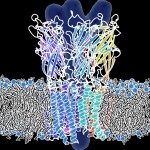Lien vers Pubmed [PMID] – 2196557
Lien vers HAL – Cliquez ici
Lien DOI – 10.1093/protein/3.6.461
Protein Eng. 1990 May;3(6):461-7.
With the great availability of sequences from RNA- and DNA-dependent RNA and DNA polymerases, it has become possible to delineate a few highly conserved regions for various polymerase types. In this work a DNA polymerase sequence from bacteriophage SPO2 was found to be homologous to the polymerase domain of the Klenow fragment of polymerase I from Escherichia coli, which is known to be closely related to those from Staphylococcus pneumoniae, Thermus aquaticus and bacteriophages T7 and T5. The alignment of the SPO2 polymerase with the other five sequences considerably narrowed the conserved motifs in these proteins. Three of the motifs matched reasonably all the conserved motifs of another DNA polymerase type, characterized by human polymerase alpha. It is also possible to find these three motifs in monomeric DNA-dependent RNA polymerases and two of them in DNA polymerase beta and DNA terminal transferases. These latter two motifs also matched two of the four motifs recently identified in 84 RNA-dependent polymerases. From the known tertiary architecture of the Klenow fragment of E. coli pol I, a spatial arrangement can be implied for these motifs. In addition, numerous biochemical experiments suggesting a role for the motifs in a common function (dNTP binding) also support these inferences. This speculative hypothesis, attempting to unify polymerase structure at least locally, if not globally, under the pol I fold, should provide a useful model to direct mutagenesis experiments to probe template and substrate specificity in polymerases.

